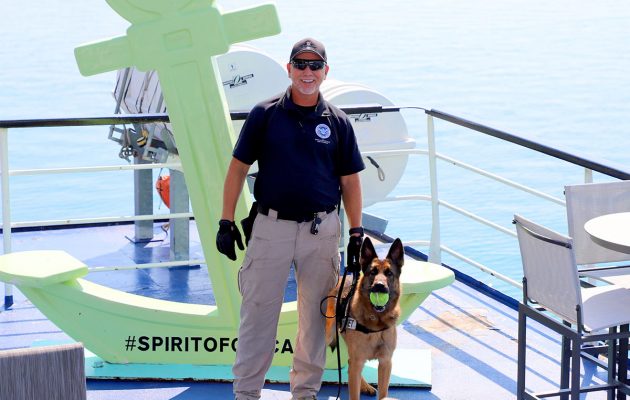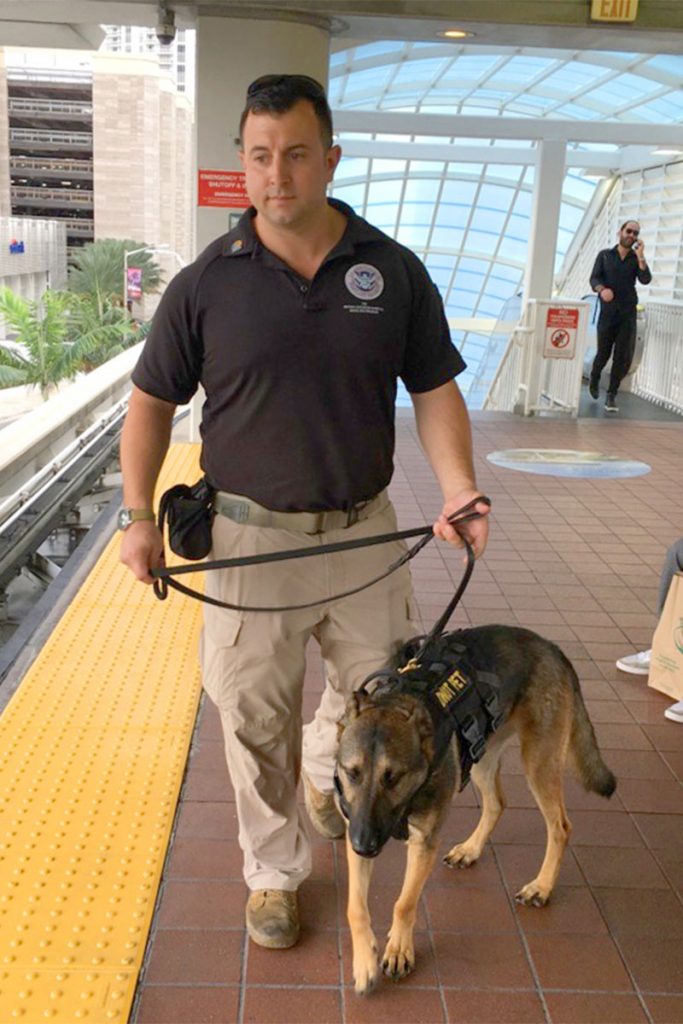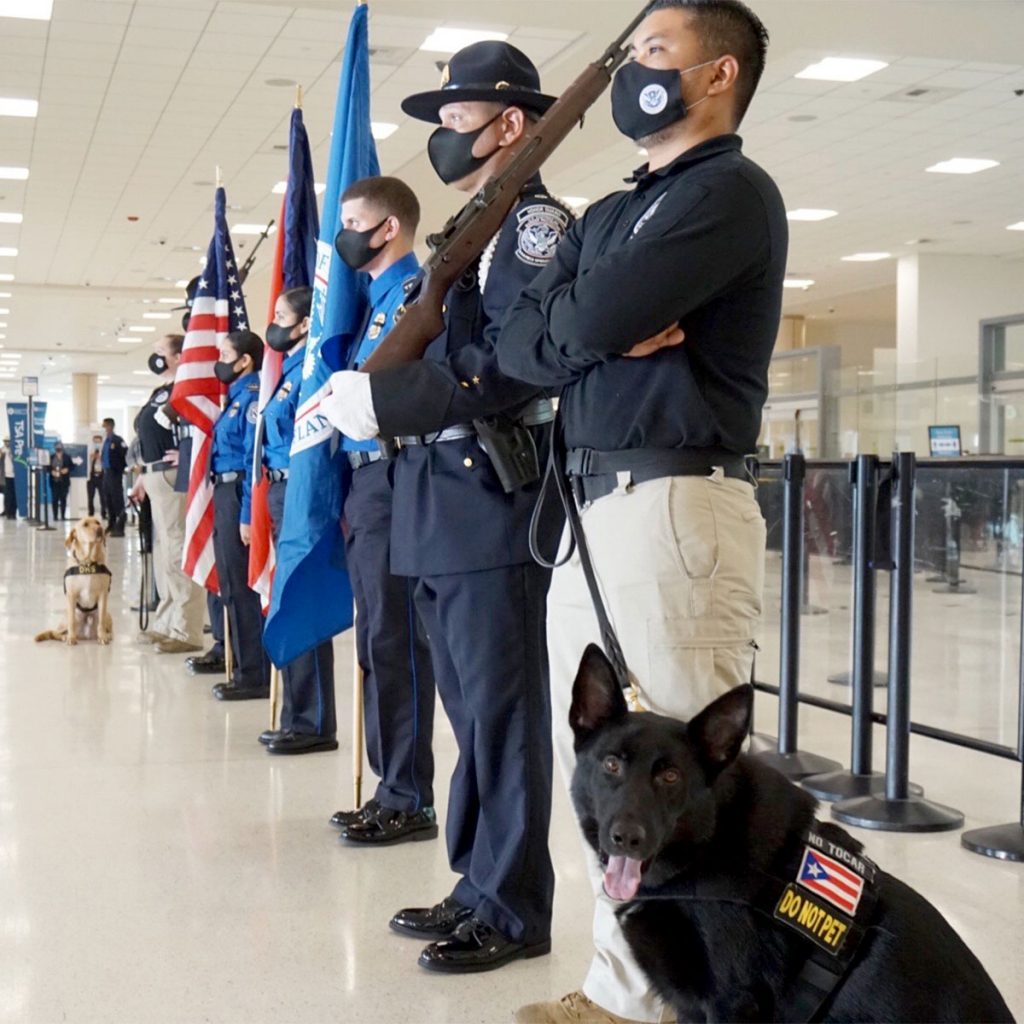Animal House: Transportation Security Administration Canines & Officers

Detecting Explosives to Protect People & Transport
The canine and officer explosives detection teams that graduate from the Transportation Security Administration’s $12 million Canine Training Center at Joint Base San Antonio-Lackland in Texas protects people and transportation hubs by detecting and locating explosives. Among those graduates are Jacksonville’s TSA-trained bomb-sniffing canines and the officers who handle them. These local, expert TSA canine explosives detection teams protect and patrol Jacksonville International Airport, Jaxport, Duval County Courthouse, attend major local events and respond to threats.
With the mission to protect citizens and the nation’s transportation system from explosives, TSA canine teams work to ensure safe travel to and from destinations whenever passengers in Jacksonville or elsewhere in the U.S. board an airplane, bus, train, ship, ferry, or subway. Approximately 100 TSA teams are assigned to U.S. airports, mass transit, and maritime sites. At any given time, more than 1,000 TSA canine teams are on active duty throughout the country.
Wherever crowds gather to see a president, cheer teams at college championship games, NFL playoffs, or a Super Bowl, celebrate the nationally televised July Fourth celebration from the U.S. Capitol, crowd sidewalks at the Macy’s Thanksgiving Day Parade or New Year’s Eve Countdowns, TSA canine explosives detection teams are present to patrol and protect. The teams also serve as a visible deterrent to terrorism, acts of violence, criminal activity and support other security missions when needed.
About forty percent of those officers who graduate from the TSA Canine Training Center are TSA inspectors. Approximately sixty percent of the graduates are local or state law enforcement officers from police departments across the country who travel to the center to be trained and paired with a TSA explosives detection canine. After the first week in the program, officers are assessed by trainers who pair them with compatible canines.

Most canine handlers accepted into the TSA Canine Training Program are already TSA officers with some canine or military experience. Other applicants must have law enforcement, military or canine experience to be considered for acceptance by the program.
Once the TSA national canine training center partners with a police department, that relationship continues past a team’s graduation, according to Patricia Mancha, TSA Spokesperson- San Antonio. She described it as a partnership to maximize and further extend the capabilities of trained teams and TSA’s commitment to protecting the nation. She said that locations with no TSA canine explosives detection teams at smaller airports would be an example. The local police department would deploy their TSA canine team to that airport in response to any threat and vice versa.
TSA’s canine training center is the second largest such program in the U.S., second only to the U.S. Department of Homeland Security-Department of Defense canine unit, according to Mancha. The center hires professional actors of all ages, appearances, and ethnicities, complete with actual luggage, to serve as passengers. Every effort is made to duplicate a typical airport’s activity, sights, sounds, and smells.
The training center has seventeen indoor venues that look like full-scale transportation sites. There is an airport terminal, gate area, cargo loading, checkpoint areas, baggage claim, full-size airplanes, interiors, and cargo belly. There is a vehicle parking lot, a light rail station and railcars, an air cargo facility, two mock terminals, and open area search venues for air scent detection training.
The scope of the TSA program increases the graduates’ capacity for rapid response, deployment, and successful explosives detection anywhere there is a threat to citizens or the U.S. transportation system. The teams also utilize a variety of training venues in and around the San Antonio metropolitan area, including the San Antonio International Airport, local shopping malls, the ATT Center, and the VIA Bus Terminal. Through such extensive and comprehensive training, the TSA canine teams offer one of the most effective means of detecting explosives threats, according to Sari Koshetz, TSA Spokesperson-Florida.
Koshetz emphasized that TSA canines can efficiently screen large numbers of passengers in numerous transportation facility types and locations, under all conditions, including terminals, vessels, vehicles, buildings, baggage, and cargo. Each TSA canine’s extraordinary sense of smell is fine-tuned through intense, specific training they receive at the center. The canines and officers also complete continuous training and require annual re-certification.
The annual on-site TSA Canine Team Re-certifications that are required continually assess and ensure that both canines and handlers demonstrate proficiency in their home environment. Four key elements are evaluated: the canine’s ability to recognize explosives odors, the handler’s ability to interpret the canine’s change of behavior, the handler’s ability to conduct logical and systematic searches and the team’s ability to locate the explosives odor source.
Only seven dog breeds qualify for the TSA Canine Training Program. They are purchased from specialized U.S. and European breeders who adhere to strict TSA requirements. Both male and female dogs are eligible: German Shepherds, Labrador Retrievers, German Short-haired Pointers, Wirehaired Pointers, Vizslas, Belgian Malinois, and Golden Retrievers.
TSA trainers choose canines specifically bred for their size, intelligence, scent detection ability, athleticism, endurance, energy level, work ethic, focus, and trainability. The trainers travel to evaluate potential dogs in a lengthy process of screening and tests before final selection.

Because of the stringent selection criteria and testing, only a low percentage of selected dogs fail to graduate from the program. After dogs and officers are evaluated and matched as a team based on trainer assessment, they begin the training program. The program consists of work with various explosives based on intelligence data and emerging threats in cooperation with the FBI.
Conventional explosives detection canines and handlers undergo an eleven-week training program costing approximately $33,000. Passenger screening canines and handlers complete a sixteen-week training program costing roughly $46,000.
The teams graduate from the TSA Canine Training Program after demonstrating proficiency in multiple transportation environments: airport, terminal, freight, cargo, baggage, vehicle, bus, ferry, and rail. After teams graduate, they return to their assigned duty station at a TSA site or a police department to acclimate and familiarize the canine with their operational environment and duties.
TSA explosives detection canines are much like elite athletes. Their daily schedule is closely monitored to enable them to perform their duties at peak ability for maximum longevity. They are fed specific diets for optimal health and performance. They are weighed daily, with monthly veterinarian check-ups, and maintain structured work and rest schedules.
Before its administration by the TSA – which was created in response to the September 11, 2001, terrorist attacks — the first federal explosives detection canines program was part of the Federal Aviation Authority by order of President Richard Nixon. In 1972 he called for a national project to protect civil aviation — an FAA Explosives Detection Canine Team Program – after a bomb-sniffing dog prevented a near-catastrophic event on board a U.S. commercial airplane during flight.
On March 9, 1972, that flight on Trans World Airlines took off from JFK International Airport in New York. Moments into the flight, the airline received an anonymous phone call warning that a bomb was set to explode onboard. The aircraft returned to JFK, passengers evacuated, and a bomb-sniffing dog named Brandy rushed to search the plane. Brandy found the explosive device just twelve minutes before it was set to detonate.
TSA would like the public to know that while TSA canines live and work with their officer handlers and enjoy a healthy life/work balance, treats are never handed to them. The dogs work to earn rewards or a chew toy after the successful completion of their jobs. Because of their strict diet and training, TSA representatives respectfully request that the public restrain children and never approach, touch, pet, feed, or distract working TSA explosives detection canines. A request for a photo is acceptable, but please honor the officer’s response as these teams focus on their critical jobs protecting the public.
By Julie Kerns Garmendia
Resident Community News









